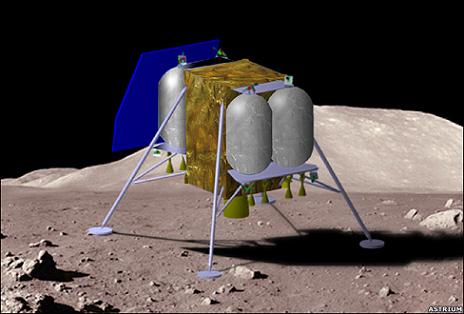The European Space Agency wants to try these technologies in preparation for launching a spacecraft to bring soil samples from Mars

British engineers are planning a mission to land a lander on the moon that will test technologies that will also be used for Mars. The concept of the Moon Twins (MoonTwins) talks about landing two spacecraft on the surface of the moon - one at each pole, which will carry out scientific experiments. The work is carried out at the facilities of the aerospace manufacturer Astrium, at the request of the European Space Agency.
The European Space Agency eventually plans to reach Mars to extract rocks there for analysis on Earth and the moon seems like a good place to develop the knowledge. "The task of bringing soil samples from Mars will be challenging and the Moon Twins will be able to help us understand some of the technological components they will require" says Mike Healy, Director of Space Sciences at Astrium. The agency expects to fly the experimental spacecraft between 2015-2018. The agency will propose several designs until it decides on the final architecture of the spacecraft.
Moon tremors
In the Moon Twins spacecraft (the term MoonTwins means Moon Technological Walk-through and In-situ Network Science), both spacecraft will be launched on the same rocket but will make their way to the moon separately.
In lunar orbit, they will perform a docking experiment - a maneuver that will be required in any multi-stage mission to Mars - before separating and descending to the lunar surface. As mentioned, the main emphasis will be on demonstrating technologies, with each of the spacecraft planned to make a soft and controlled landing at a precise location near the relevant pole. Each spacecraft will carry a seismometer and with it will sense the moon's tremors, providing scientists with a new way to study the interior of our natural satellite.
Apparently, the twins will be large enough to carry additional devices. "They won't have the developed ability to move, but it will be possible to move them on the ground for short distances, maybe jump to a new place," says Dr. Healy.
Water sources
The moon is about to become a popular target for research, both the Chinese and the Japanese are supposed to launch spacecraft to orbit it in the coming year. In 2009, spaceships from India and the USA are expected to be launched. Astrium is also involved in the development of a new all-terrain vehicle for Mars.
According to the plan, the astronauts will return to the surface of the moon around the year 2020. At least one of the lunar twins will be launched to one of the most important places for human settlement - the peak of eternal light. It is close to the rim of Shackleton Crater near the South Pole. The peak experiences almost non-stop light, which makes it an excellent location for a site to build solar collectors. The crater itself is the opposite, it is always in shadow. "This is a good landing site because there may be hydrogen in the crater," explains the European Space Agency's chief lunar scientist, Dr. Bernard Poing.
The question of whether the hydrogen originated from water in the icy state of accumulation or whether it is only remnants of hydrogen from the solar wind that mixed in the lunar soil remains open, but even if there is only hydrogen, if it is mixed with oxygen, water can be formed.
According to Poing, the agency will seek proposals from various groups before determining the mission's target and design. Space ministers in European countries will be required to approve the final details," he said.
The mission of returning soil samples from Mars in order to bring rocks from Mars to Earth for analysis is a high priority among the goals of the European Space Agency. It will be one of the most complex planetary missions ever proposed. All steps of the task must be error-proof:
- Launching a spacecraft to Mars and landing it safely
- Dig below the surface to collect a variety of samples
- Sealing the samples in the container
- Launching the samples into orbit around Mars
- Transferring the samples to the spacecraft that will transfer them to Earth
- travel back to earth
- Land safely on Earth
- Ensure 100 percent protection of the samples so that you do not bring contamination from Adimai to Earth (and vice versa) as well as during landing
The cost of the operation means that Europe will be able to carry out the project only through cooperation with other parties, almost certainly with the USA. The technology demonstration will help determine which aspects of the mission will be built by Europe and which will be left to a partner. The future missions of the European Space Agency were discussed last week in the General Plenary at the European Geophysical Union conference.

3 תגובות
It's a shame to waste money (at least at this point) on sending people to the moon or other planets, with the technologies we have today, it is possible to quietly send sophisticated robots that will land on these planets and transmit any type of information back to Earth through their cameras and sensors, and if they really, really want, they can They will take samples and bring them back to Earth for testing, there is no need to send humans at the moment, it's a shame to waste resources, with proper planning a robot will do the job well enough.
The reason is financial - NASA's current budget is less than a tenth of its size during the Apollo days.
A question to Avi Bilovsky why the United States does not land a man on the moon like in the past